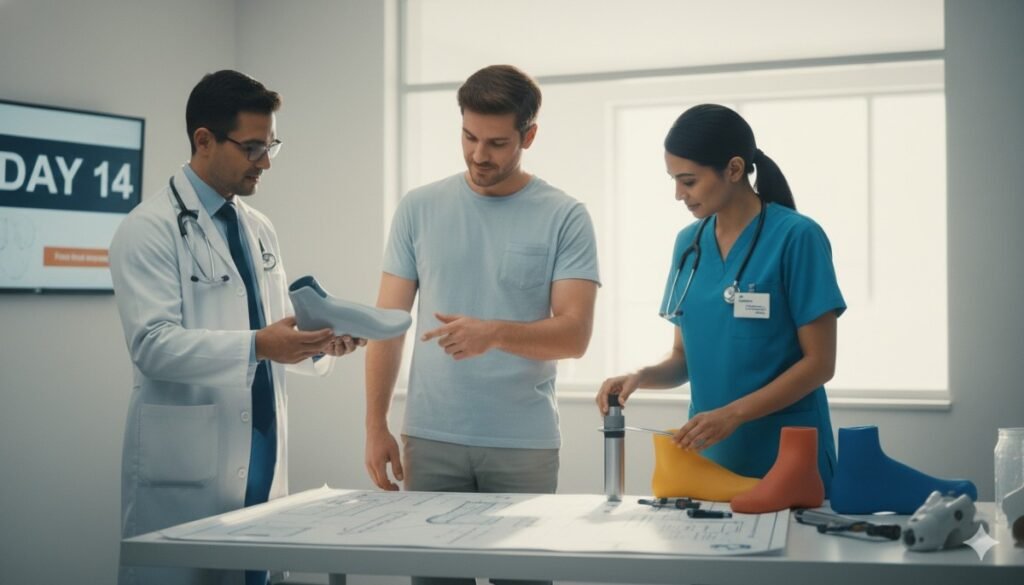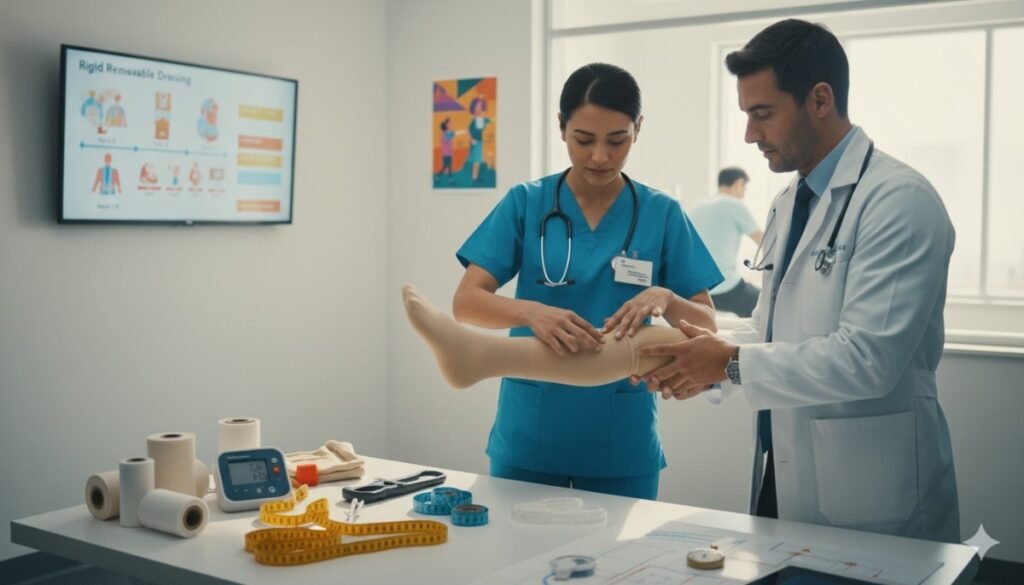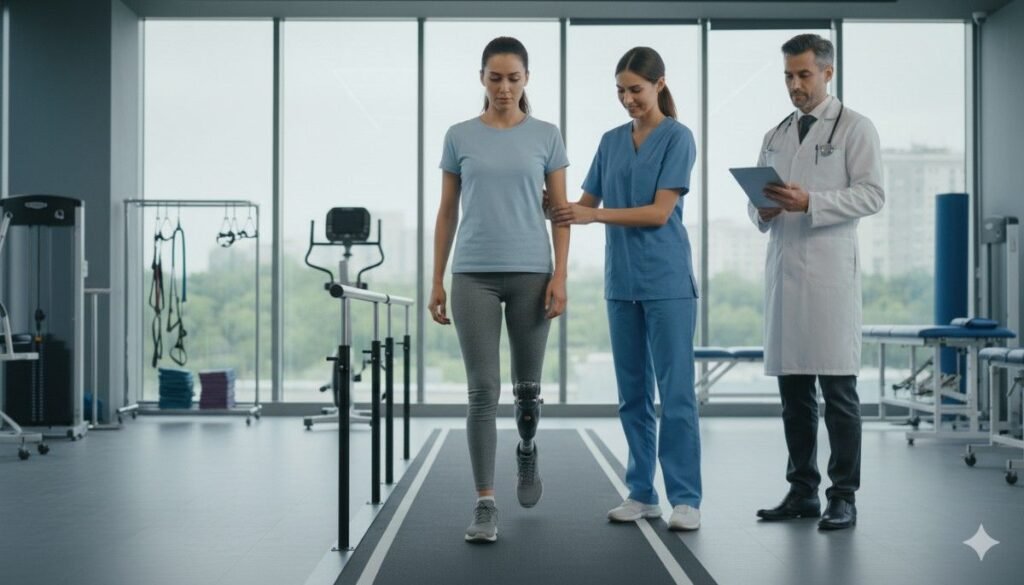Every patient who receives a prosthetic limb dreams of walking, moving, and living freely again. For doctors, it’s equally rewarding to witness that progress — to see someone take their first confident steps or regain the use of their hand. Yet beneath that excitement lies a delicate truth: progress in prosthetic rehabilitation must be carefully timed.
Moving too fast, before the body and mind are truly ready, can cause setbacks that are difficult to undo. The first few weeks of prosthetic use are a balance between motivation and caution. Doctors must constantly read the signs, knowing when to encourage progress and when to pause.
These “red flags” are subtle at first — a bit of swelling here, skin irritation there, or unusual fatigue during training. But for trained eyes, they signal the need to slow down, reassess, and protect the patient’s recovery. Ignoring them can lead to complications that delay long-term success.
This article is a detailed guide for physicians and rehabilitation specialists on recognizing those warning signs. It walks through the physical, emotional, and functional indicators that suggest a patient isn’t ready for faster progression. It also discusses how to communicate these pauses with compassion, ensuring patients remain motivated even when recovery takes a step back.
Let’s begin by understanding what early prosthetic progression really means — and why the pace of adaptation can make all the difference between short-term struggle and lifelong success.
Understanding Early Prosthetic Progression
What Early Progression Means

Early prosthetic progression refers to the initial phase when patients begin using their prosthesis after fitting. This includes first-time wear, short training sessions, and early functional movements guided by physiotherapists or occupational therapists.
During this time, the body is still adjusting. Muscles are learning new patterns, the residual limb is changing shape, and the brain is building new connections to control the prosthetic device. Progress must be slow and deliberate.
Many patients, excited to regain normalcy, tend to push themselves too quickly. It’s the doctor’s responsibility to help manage expectations and ensure safety without discouraging motivation.
The Role of the Physician in Early Adaptation
Doctors serve as both protectors and guides in this journey. They monitor healing, inspect the residual limb for stress, and evaluate socket fit, skin condition, and overall readiness.
Physicians must balance enthusiasm with caution. Encouraging too much activity too soon can lead to complications that might delay recovery for weeks or even months.
Regular reassessments and open conversations with the rehabilitation team ensure that each stage of progression matches the patient’s physical readiness and emotional stability.
Why Pace Matters
Every body heals at its own speed. While some patients may adapt quickly, others require more time to build strength, endurance, and confidence. Pushing too far beyond comfort risks setbacks such as tissue breakdown, nerve irritation, or emotional burnout.
Controlled, gradual progression allows the body to adapt naturally to new loads and movement patterns. It helps the brain accept the prosthesis as part of the body rather than a foreign object.
The safest way to progress is always steady, never rushed.
Why Doctors Must Monitor Pace Closely
The First Few Weeks Define Long-Term Success
The initial weeks after fitting set the tone for everything that follows. During this period, the residual limb is highly sensitive and prone to change. Skin texture, tissue density, and circulation all shift as the limb interacts with the socket and liner.
Even minor missteps — like wearing the prosthesis too long or performing difficult movements early — can cause irritation that leads to infection or socket discomfort.
That’s why doctors insist on structured wear schedules, gradually increasing daily use only when the skin and muscles show readiness.
Balancing Motivation and Safety
Most patients want to progress faster. They’re eager to walk again, lift again, or simply feel “normal.” Doctors, however, must help them channel that motivation safely.
If enthusiasm overrides caution, patients may ignore early warning signs of strain. Gentle education about the importance of pacing can turn impatience into trust.
This delicate balance defines good prosthetic care: inspiring progress while preventing harm.
The Signs of Healthy Progress
When progression is well-paced, the patient’s body and mind show harmony. Skin remains healthy, muscles grow stronger, and control improves steadily.
There’s little to no pain, and socket comfort increases with use. The patient feels more confident but not exhausted after training sessions. These are indicators that the schedule is just right.
Doctors should celebrate these small, steady milestones—they build confidence without overexertion.
The Cost of Ignoring Early Red Flags
When red flags go unnoticed, small irritations turn into bigger complications. A patch of redness can evolve into a sore; a bit of swelling can signal deep tissue stress.
Ignoring early symptoms doesn’t only cause physical issues—it also damages trust between doctor and patient. If pain grows without explanation, patients may feel discouraged or even blame themselves.
That’s why timely pauses, adjustments, and explanations are crucial. They protect not just the limb but also the patient’s mindset.
Physical Red Flags That Require Immediate Attention
Persistent Skin Redness

Some redness after initial use is normal, especially in pressure-bearing areas. However, redness that lingers for more than 20 minutes after removing the prosthesis signals excess pressure.
This means the socket isn’t distributing weight evenly or that the limb volume has changed. Doctors should reassess socket alignment, liner fit, and suction strength immediately.
If ignored, this can lead to blistering or deep tissue injury—conditions that may require a complete break from prosthetic use until healing occurs.
Swelling and Fluid Retention
Swelling can occur for many reasons, from improper fit to overuse. If the limb looks puffier after wearing the prosthesis, it’s a red flag that circulation is being restricted.
Doctors often check for tight suspension or liner constriction. The solution might involve reducing wear time or modifying padding to relieve pressure.
Unchecked swelling can lead to poor tissue oxygenation, slowing healing and increasing discomfort.
Pain That Persists Beyond Adjustment
Mild soreness is expected as muscles adapt to new loads. But pain that lasts beyond 24 hours or increases with each use is a clear warning sign.
It can indicate poor alignment, nerve compression, or excessive socket pressure. Physicians must halt prosthetic progression until the cause is identified and resolved.
Pain should never be normalized as “part of getting used to it.” Persistent pain always deserves attention.
Skin Breakdown or Wound Formation
If a wound, blister, or rash appears on the residual limb, progression must stop immediately. Continued use will only worsen the condition and may lead to infection.
Doctors usually prescribe a rest period, topical treatments, and refitting after healing. In severe cases, imaging may be needed to rule out deeper tissue damage.
Healing first ensures long-term comfort later. Pushing through pain only delays success.
Excessive Sweating or Odor
While sweating is common, excessive moisture can cause bacterial growth and liner slippage. If odor or itching appears, it often signals poor ventilation or hygiene.
Doctors should advise patients on proper cleaning routines, breathable liners, and rest intervals. Managing moisture early prevents bigger problems later.
Mechanical and Technical Red Flags
Socket Looseness or Rotation
When the socket feels loose or rotates during movement, it compromises stability. Patients might describe a “twisting” sensation or hear clicking sounds.
This means the fit is no longer optimal—often due to limb volume loss or suspension wear. Continuing use in this state increases the risk of friction and skin damage.
A quick evaluation and refitting prevent unnecessary strain and restore balance.
Uneven Pressure Distribution
If one part of the limb bears more load than others, discomfort soon follows. Uneven weight can alter gait or lead to sores on bony areas.
Doctors assess pressure marks and adjust alignment or insert liners to distribute force evenly. Regular socket checkups ensure long-term comfort and safety.
Mechanical Malfunction
For patients using bionic or myoelectric limbs, irregular movement, delayed response, or unwanted grip release can indicate sensor or calibration issues.
Doctors should pause advanced training until technicians inspect the device. Continuing training with malfunctioning components risks muscle strain or loss of confidence in control.
At RoboBionics, we emphasize early detection through guided user feedback and regular maintenance—preventing these interruptions from turning into frustrations.
Changes in Limb Volume
Limb volume changes can happen rapidly in the early months. A reduction as small as a few millimeters can shift how the socket fits.
If the patient reports new looseness, it’s time for reassessment. Using prosthetic socks temporarily can help, but long-term solutions may involve recasting or resizing.
Ignoring this red flag leads to instability and skin friction—both avoidable with quick adjustments.
Functional and Behavioral Red Flags
Decline in Activity Tolerance

If a patient who once comfortably wore the prosthesis for four hours can now manage only two, something has changed. It could be physical, mechanical, or emotional—but it’s a sign to pause.
Doctors must evaluate muscle fatigue, fit, and psychological comfort before resuming progression. Sometimes, the issue isn’t physical—it’s the body asking for rest.
Hesitation or Fear During Use
Some patients begin showing fear or hesitation while using the prosthesis, especially after a painful experience. They might move more slowly or avoid certain tasks.
This emotional red flag signals that discomfort or anxiety has set in. The doctor should slow down training and re-establish trust by ensuring comfort first.
Confidence must grow before progression resumes.
Over-Compensation by the Other Limb
If the patient starts putting more effort into the sound limb, it means the prosthetic side isn’t functioning comfortably. Overuse of one side can cause posture imbalance and joint pain.
Doctors must investigate whether the issue lies in fit, alignment, or training technique. Proper correction ensures symmetry and prevents long-term strain.
Emotional Fatigue or Frustration
Early prosthetic training can be emotionally draining. If a patient appears withdrawn, anxious, or unmotivated, it’s a cue to slow down.
Doctors should open a gentle dialogue, validating the patient’s feelings. Sometimes, simply reducing session intensity helps restore confidence. Emotional recovery is as important as physical progress.
Sleep Disruptions and Chronic Fatigue
Patients struggling with socket discomfort or residual pain often lose sleep. This affects healing and concentration during rehabilitation.
When fatigue becomes consistent, it’s time to pause progression. Restoring sleep and energy ensures better focus and physical readiness for the next stage.
Clinical Decision-Making When Red Flags Appear
Knowing When to Pause
Pausing prosthetic progression doesn’t mean failure. It means protection. When the body shows signs of stress, the doctor’s first responsibility is to prevent further damage.
Pausing gives the limb time to heal, the socket time to be adjusted, and the patient time to rebuild confidence. The decision to pause is not reactive; it’s strategic. It prevents small problems from becoming permanent setbacks.
How to Evaluate the Severity
Not all red flags carry the same weight. Some, like mild redness or short-term soreness, can be monitored. Others—such as open wounds, swelling, or deep pain—require immediate rest and reassessment.
Doctors begin by classifying the concern as minor, moderate, or severe. Minor issues may need rest for a day or two. Severe cases may call for suspension of all prosthetic activity until full recovery.
This structured approach ensures safety without overreaction. It keeps both doctor and patient aligned on expectations.
Physical Assessment Steps
When a red flag appears, the physician begins with a careful examination of the residual limb. The inspection includes:
- Checking for color changes or broken skin
- Assessing tissue firmness and warmth
- Evaluating range of motion and pain response
Next, the doctor checks the prosthesis. They inspect the socket’s internal surface, liner condition, and suspension mechanism. The goal is to find out whether the problem lies with the limb, the device, or the user’s routine.
The Value of Data and Documentation
Every red flag should be recorded. Keeping consistent records of skin condition, fit issues, and pain patterns helps track improvement and identify recurring problems.
Photos taken at each visit can reveal subtle changes over time. This data supports clinical decisions and gives patients a sense of clarity—they can see progress in measurable terms.
Documentation also strengthens teamwork between the doctor, prosthetist, and therapist. Everyone works from the same information, which keeps care consistent.
When to Involve the Prosthetist
If the issue appears to be mechanical, such as poor fit or socket pressure, the prosthetist should be involved immediately. Collaboration allows for simultaneous adjustments in design and medical treatment.
Doctors handle the health side, while prosthetists fix mechanical alignment. Together, they ensure that no aspect of care is overlooked.
A quick, combined response often means the difference between a short break and a prolonged interruption.
Emotional and Psychological Support During a Pause
The Patient’s Perspective
For many patients, being told to “pause” prosthetic training can feel like losing progress. It may trigger disappointment, anxiety, or fear of going backward. Doctors must remember that emotions play a huge role in recovery.
Acknowledging these feelings helps. When patients understand that a pause is protective—not punitive—they are more likely to cooperate. Compassion turns what could feel like a setback into a moment of trust.
Communicating the Pause
The way the doctor explains the pause makes all the difference. Instead of saying, “You can’t continue,” it’s more effective to say, “Your body needs rest so you can move forward safely.”
This approach frames rest as progress, not restriction. It keeps motivation alive while reinforcing the importance of safety.
Doctors should be clear about duration, reason, and next steps. Vague explanations only add confusion or frustration.
Encouraging Patience Through Perspective
Progress in prosthetic rehabilitation is never a straight line. Some days bring breakthroughs; others bring slowdowns. When patients learn this rhythm, they handle pauses with more resilience.
Doctors can share real examples—stories of others who took breaks and returned stronger. It helps patients see that recovery isn’t measured in days but in readiness.
Managing Fear of Regression
Many patients fear that taking a break will undo the hard work they’ve done. It’s important to reassure them that a pause protects long-term function. Muscles may rest, but memory and training stay intact.
Doctors often prescribe gentle exercises that keep circulation active during rest periods. This maintains connection between brain and limb without stressing the socket.
Rebuilding Confidence After a Pause
When it’s time to resume, doctors should restart training gradually. Small, achievable goals help the patient regain confidence.
Positive reinforcement goes a long way. Acknowledging every bit of progress—no matter how small—reminds patients that setbacks are temporary, but determination lasts.
Communication Strategies for Doctors
Listening as a Diagnostic Tool

Listening is as powerful as examination. Often, patients describe subtle sensations that point directly to the problem. A doctor who listens closely can detect issues before they become visible.
Simple questions like “When did this start?” or “What does it feel like when you move?” can reveal critical details. The tone should always be calm and conversational, never rushed.
When patients feel heard, they speak more openly—and that honesty leads to better care.
Using Simple Language
Medical terms can confuse or intimidate patients. Clear, simple words build understanding. Instead of saying “soft tissue inflammation,” say “the muscles are irritated.”
When explanations are easy to grasp, patients are more likely to follow instructions. Understanding creates trust, and trust creates compliance.
Balancing Honesty and Hope
It’s vital to be transparent about risks without discouraging the patient. Saying “This irritation needs rest to heal properly” is better than “You can’t wear your prosthesis for weeks.”
Tone matters as much as content. A calm, reassuring explanation shows that the pause is part of a plan, not a punishment.
Keeping Families Informed
Family members often support patients with daily routines—helping with cleaning, checking skin, or managing schedules. Keeping them informed ensures consistent care.
Doctors should involve them in discussions, showing them how to recognize red flags and when to call for help. Empowered families make safer recoveries.
Documenting Communication
Notes from conversations are as important as medical records. They capture the emotional state, concerns, and understanding of the patient.
Documenting these discussions helps build continuity of care and reminds future clinicians of key turning points.
Preventing Red Flags Before They Start
The Power of Gradual Training
The simplest way to prevent setbacks is to progress slowly. Doctors and therapists can design a structured schedule that increases wear time by minutes, not hours.
Starting small allows the skin and muscles to adapt naturally. Each increase should only happen when the limb shows no signs of distress.
This slow approach may feel cautious, but it’s the fastest route to long-term success.
Early Education on Warning Signs
Doctors should teach patients how to identify potential issues from day one. If patients can spot redness, swelling, or fit changes early, they can seek help before problems escalate.
Handouts, photos, or simple checklists make learning easier. The goal is to turn every patient into their own daily observer.
Regular Follow-Up Appointments
Follow-ups are not formalities—they are preventive tools. Each visit allows doctors to assess progress, update care plans, and catch early warning signs.
Ideally, appointments should occur weekly in the first month, then biweekly as stability improves. Frequent checks keep issues manageable and predictable.
Collaborating with Prosthetists and Therapists
Prevention works best when all care providers work together. Prosthetists, physiotherapists, and doctors should share updates regularly.
This coordination ensures that no one works in isolation. A therapist noticing balance changes can alert the doctor before pain develops. A prosthetist seeing fit issues can request a review before irritation begins.
Together, they create a seamless care experience.
Encouraging Realistic Expectations
Many patients dream of returning to full function quickly. Doctors can gently explain that rehabilitation is not a race. The goal is not speed—it’s sustainability.
Setting small, achievable targets keeps morale high. Each safe milestone achieved builds trust in the process.
Doctor–Patient Collaboration in Early Phases
Shared Decision-Making
When both doctor and patient participate in care decisions, outcomes improve. Shared decision-making gives patients a voice and responsibility in their own recovery.
Doctors can outline options—such as adjusting wear time or changing liners—and explain the pros and cons. This helps patients feel empowered rather than controlled.
Shared ownership creates commitment to the plan.
Building a Transparent Relationship
Transparency builds loyalty and reduces anxiety. When doctors explain every step clearly—why something is paused, how it will be fixed, and what comes next—patients stay calm and cooperative.
Clarity replaces fear with trust, turning treatment into partnership.
Encouraging Continuous Feedback
Feedback is crucial, not just from patients but also from caregivers and therapists. Doctors should actively invite feedback rather than wait for complaints.
Regularly asking “How did it feel this week?” or “What was different today?” uncovers hidden issues before they grow.
The more dialogue there is, the smoother the journey becomes.
Celebrating Progress Together
Every reassessment should highlight not just what went wrong but also what went right. Recognizing progress strengthens morale.
Even small victories—like reduced redness or longer wear times—deserve celebration. Doctors who recognize these moments help patients see that progress continues, even when slowed.
Long-Term Prevention of Red Flags
The Importance of Consistency

Consistency is the quiet hero of rehabilitation. When patients follow their routines with care—wear schedules, cleaning, and exercises—the body learns stability.
Doctors emphasize routine not as repetition but as reinforcement. Every consistent habit builds stronger skin, steadier muscles, and deeper trust in the prosthesis.
Consistency helps the body recognize the prosthesis not as a tool, but as part of itself.
Monitoring Beyond the First 90 Days
While the early months demand the most vigilance, follow-ups shouldn’t stop there. The body continues to evolve for up to a year after amputation.
Doctors recommend periodic checkups even after the limb stabilizes. Subtle volume shifts or new activity levels can still trigger irritation if unnoticed.
Long-term prevention relies on early communication—patients who report changes promptly make care simpler and safer.
Skin Care as a Preventive Practice
Healthy skin is the foundation of prosthetic success. Doctors teach patients to treat the residual limb as gently as the face—clean daily, dry completely, and moisturize at night.
Smooth, strong skin resists friction better than dry, irritated skin. Using breathable liners and avoiding harsh soaps keeps the limb in good condition.
Simple care habits reduce more complications than any advanced adjustment can fix later.
The Role of Exercise and Circulation
Good circulation feeds healthy tissue. Gentle exercises—stretching, limb elevation, and residual limb massage—help maintain blood flow and prevent swelling.
Doctors can recommend daily movement routines that don’t strain the socket area. These small exercises strengthen confidence and prevent stiffness.
A well-circulated limb heals faster, tolerates pressure better, and stays ready for steady progression.
Early Intervention Programs
Many prosthetic centers now use proactive monitoring programs. These include monthly check-ins, digital photos, and self-assessment tools.
At RoboBionics, our partner clinics encourage patients to send updates remotely. If redness or fit changes appear, our specialists respond quickly with guidance or adjustments.
This proactive approach replaces crisis management with preventive care.
Emotional Reintegration After Setbacks
Accepting the Pace of Healing
Recovery after amputation is not a straight road—it’s a winding path with rest stops. Doctors remind patients that pauses don’t mean regression; they mean listening.
When setbacks occur, patience is the most healing medicine. Accepting that the body needs time builds resilience and maturity in the recovery journey.
The best outcomes often come from those who learned to respect their body’s rhythm.
Reframing Setbacks as Lessons
Each pause carries a lesson. It teaches what triggers irritation, what motion feels natural, and where the body still needs strength.
Doctors can help patients reframe these pauses as feedback, not failure. When seen as learning moments, setbacks strengthen awareness and confidence.
Every healed sore, every realignment, every day of rest teaches something valuable about adaptation.
The Emotional Weight of Pain
Pain can erode motivation faster than anything else. When discomfort sets in, fear often follows. Patients may start to believe they’ll never get comfortable again.
This is where empathy matters most. Doctors can use reassurance and shared experiences to restore hope. A calm explanation of what’s happening—and what will be done—can lift fear instantly.
Clear communication and emotional presence heal more than medication ever can.
Building Emotional Endurance
Emotional endurance grows like physical strength—one challenge at a time. Doctors help patients build this resilience by focusing on what’s controllable: small wins, daily comfort, and realistic expectations.
A steady emotional foundation makes it easier to recover from pauses and start again with optimism.
Encouraging Mind-Body Connection
Mindfulness and relaxation techniques, such as deep breathing or guided visualization, can reduce pain perception and anxiety.
Some rehabilitation centers combine these with mirror therapy, allowing patients to reconnect mentally with their bodies. When the mind feels calm, the body adapts more easily.
This mind-body harmony makes future progression smoother and more sustainable.
Doctor-Guided Readiness for Progression
Recognizing True Readiness
Doctors know that readiness for prosthetic progression is more than absence of pain. It includes skin integrity, muscle strength, emotional stability, and consistent control.
Readiness is the moment when the patient wears the prosthesis comfortably for several hours, moves with confidence, and communicates any discomfort calmly.
When all these align, it’s safe to move forward.
The Stepwise Approach
Progression should follow a logical pattern. Doctors and therapists often design stepwise programs—starting with basic wear, then standing balance, then walking, lifting, or gripping.
Each new activity tests readiness without rushing it. If no red flags appear, the patient advances; if signs of stress show, the pace slows.
This structured system protects recovery while keeping momentum alive.
Coordination with the Prosthetist
Before increasing activity, the doctor consults the prosthetist. Together, they ensure the socket, liner, and suspension are ready for extended use.
The prosthetist may make small alignment tweaks or adjust pressure points before the doctor approves the next phase.
This teamwork eliminates surprises and prevents re-injury.
Adjusting to Real-Life Movements
Doctors often test readiness by simulating real-life situations—lifting small objects, walking on uneven surfaces, or performing simple tasks.
If the patient handles these without pain or fatigue, they’re ready for more advanced movements. Gradual exposure to real scenarios helps confidence grow organically.
Real progress isn’t just in therapy rooms—it’s in life outside them.
Emotional Readiness Matters Too
Physical readiness without mental readiness is incomplete. Some patients may hesitate even when physically healed. Others may feel eager but mentally exhausted.
Doctors should discuss emotional comfort openly before advancing stages. Confidence and calm are signs that both body and mind are aligned for success.
Sustaining Progress Safely
Continuous Monitoring
Even after progression resumes, monitoring continues. Doctors look for small changes—skin tone, posture, gait, or patient expression.
These subtle cues often reveal comfort levels better than words. Continuous observation ensures that any new stress is caught before it becomes serious.
Reinforcing Education
Doctors use each visit to reinforce earlier lessons: check skin daily, report discomfort, maintain hygiene, and respect rest.
Repetition turns these into habits. Over time, the patient becomes their own best guardian.
Celebrating Stability
Once the patient can use their prosthesis comfortably through the day, it’s time to celebrate. This milestone reflects teamwork—patient discipline, medical care, and prosthetic precision.
Doctors should acknowledge this moment openly. Recognition strengthens motivation and deepens the sense of accomplishment.
Setting Up Long-Term Maintenance
Progress doesn’t end with stability; it evolves. Doctors guide patients on when to revisit for adjustments, what signs to monitor, and how to keep improving function.
Just like dental checkups or annual screenings, prosthetic reassessments keep everything aligned and healthy.
At RoboBionics, we often remind users: the goal isn’t just movement—it’s comfort that lasts for years.
Integrating Advanced Technology for Prevention
The Rise of Smart Prosthetics

Modern prosthetics now come with sensors that track pressure, temperature, and motion. These digital cues alert both users and clinicians to potential red flags before symptoms appear.
Doctors can use this data to fine-tune alignment remotely. Smart systems like our Grippy™ Bionic Hand combine comfort feedback with intuitive control, ensuring both safety and precision.
Using Apps and Remote Check-Ins
Many clinics now use companion apps to collect user feedback in real time. Patients log daily wear hours, comfort levels, and photos of the limb.
Doctors review these updates, allowing early intervention without waiting for the next visit. This digital bridge strengthens communication and builds trust.
Data-Driven Care
By analyzing patterns from smart prosthetic devices, doctors can predict potential complications. For instance, if temperature readings rise in one socket area, it may suggest pressure buildup.
Data doesn’t replace human judgment—it enhances it. Combining empathy with analytics creates modern, patient-centered care.
Local Innovation in India
RoboBionics takes pride in being part of India’s growing prosthetic innovation landscape. With over 60 locally made components, our devices combine world-class precision with affordability.
Our technology empowers doctors with better insights and gives patients access to advanced care without leaving the country.
A Future Built on Partnership
The future of prosthetics lies not only in better devices but in better partnerships—between patient, doctor, and technology. When these three work together, red flags become rare and recovery becomes natural.
At RoboBionics, we see every partnership as a lifelong journey toward independence and dignity.
Final Takeaways
Listening Is the First Line of Defense
For doctors, listening remains the most powerful diagnostic skill. Every red flag begins as a patient’s observation—a feeling, a sound, a discomfort. Paying attention early prevents major setbacks later.
A listening physician is a healing physician.
Progress at the Right Pace
Steady, mindful progress beats fast, risky gains. A prosthesis should become part of life gently, not forcefully.
Doctors who respect this rhythm ensure that their patients achieve not just mobility but lasting comfort.
Prevention Over Correction
Catching small signs early saves weeks of recovery later. Preventive care—through education, consistency, and early intervention—is the foundation of prosthetic success.
Every pause taken today prevents a barrier tomorrow.
The Doctor’s Promise
Every physician guiding a prosthetic user holds a special role—not just as a clinician but as a mentor. Their watchful care turns fragile hope into renewed independence.
At RoboBionics, we honor that partnership. We build devices that doctors can trust and patients can depend on—crafted with precision, affordability, and empathy.
Your Next Step
If you’re a physician seeking guidance for your patients, or an amputee starting your prosthetic journey, our team at RoboBionics is here to help.
Visit https://www.robobionics.in/bookdemo/ to schedule a demo or consultation. Discover how India’s leading prosthetic innovations—like the Grippy™ Bionic Hand—can transform recovery with comfort, safety, and confidence.
Because in prosthetic care, knowing when to pause is as important as knowing when to move forward.


